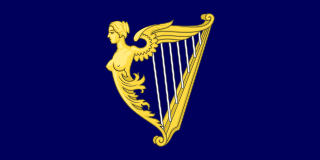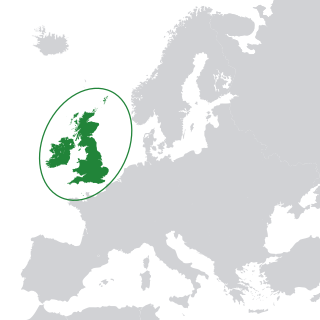
Ireland is an island in the North Atlantic Ocean.
Contents
- Polities currently located on Ireland
- Former political arrangements of Ireland
- Other places
- People
- Other uses
- See also
Ireland may also refer to:

Ireland is an island in the North Atlantic Ocean.
Ireland may also refer to:
Britain most often refers to:

This is a list of the lists of islands in the world grouped by country, by continent, by body of water, and by other classifications. For rank-order lists, see the other lists of islands below.
Clare may refer to:

Monarchical systems of government have existed in Ireland from ancient times. In most of Ireland, this continued until 1949, when it transitioned to being the Republic of Ireland. Northern Ireland, as part of the United Kingdom, remains under a monarchical system of government.

The Kingdom of Ireland was a monarchy on the island of Ireland that was a client state of England and then of Great Britain. It existed from 1542 to the end of 1800. It was ruled by the monarchs of England and then of Great Britain, and was administered from Dublin Castle by a viceroy appointed by the English king: the Lord Deputy of Ireland. Aside from brief periods, the state was dominated by the Protestant English minority. The Protestant Church of Ireland was the state church. The Parliament of Ireland was composed of Anglo-Irish nobles. From 1661, the administration controlled an Irish army. Although styled a kingdom, for most of its history it was, de facto, an English dependency. This status was enshrined in Poynings' Law and in the Declaratory Act of 1719.

Irish states have existed under a number of different names for nearly a thousand years. A unified Irish proto-state had been coalescing from the multitude of small tribal kingdoms that existed circa AD 500, similar to the pattern elsewhere in Europe. The independent development of the several dynastic regional kingdoms into a nascent national kingdom, however, was extinguished by the Norman invasion of Ireland in 1169, although these regional Gaelic Ireland kingdoms continued to resist for centuries until the Tudor conquest of Ireland was completed in the 17th century.
The parliament of the Republic of Ireland is the Oireachtas.

The terminology of the British Isles refers to the words and phrases that are used to describe the geographical and political areas of the islands of Great Britain, Ireland and the smaller islands which surround them. The terms are often a source of confusion, partly owing to the similarity between some of the actual words used but also because they are often used loosely. Many of the words carry geographical and political connotations which are affected by the history of the islands.
A political union is a type of political entity which is composed of, or created from, smaller polities, or the process which achieves this. These smaller polities are usually called federated states and federal territories in a federal government; and prefectures, regions, or provinces in the case of a centralised government. This form of government may be created through voluntary and mutual cession and is described as unionism by its constituent members and proponents. In other cases, it may arise from political unification, characterised by coercion and conquest. The unification of separate states which, in the past, had together constituted a single entity is known as reunification. Unlike a personal union or real union, the individual constituent entities may have devolution of powers but are subordinate to a central government or coordinated in some sort of organization. In a federalised system, the constituent entities usually have internal autonomy, for example in the setup of police departments, and share power with the federal government, for whom external sovereignty, military forces, and foreign affairs are usually reserved. The union is recognised internationally as a single political entity. A political union may also be called a legislative union or state union.

The Crown of Ireland Act 1542 is an Act that was passed by the Parliament of Ireland on 18 June 1542, which created the title of "King of Ireland" for monarchs of England and their successors; previous monarchs had ruled Ireland as Lords of Ireland. The first monarch to hold the title was King Henry VIII of England.

The first evidence of human presence in Ireland dates to around 33,000 years ago, with further findings dating the presence of homo sapiens to around 10,500 to 7,000 BCE. The receding of the ice after the Younger Dryas cold phase of the Quaternary around 9700 BCE, heralds the beginning of Prehistoric Ireland, which includes the archaeological periods known as the Mesolithic, the Neolithic from about 4000 BCE and the Copper Age beginning around 2500 BCE with the arrival of the Beaker Culture. The Irish Bronze Age proper begins around 2000 BCE and ends with the arrival of the Iron Age of the Celtic Hallstatt culture, beginning about 600 BCE. The subsequent La Tène culture brought new styles and practices by 300 BCE.

British rule in Ireland built upon the 12th century Anglo-Norman invasion of Ireland on behalf of the English king and eventually spanned several centuries that involved British control of parts, or entirety, of the island of Ireland. Most of Ireland gained independence from the United Kingdom following the Anglo-Irish War in the early 20th century. Initially formed as a Dominion called the Irish Free State in 1922, the Republic of Ireland became a fully independent nation state following the passage of the Statute of Westminster in 1931. It effectively became a republic with the passage of a new constitution in 1937, and formally became a republic with the passage of the Republic of Ireland Act in 1949. Northern Ireland remains part of the United Kingdom as a constituent country.
The following outline is provided as an overview of and topical guide to the history of the British Isles: